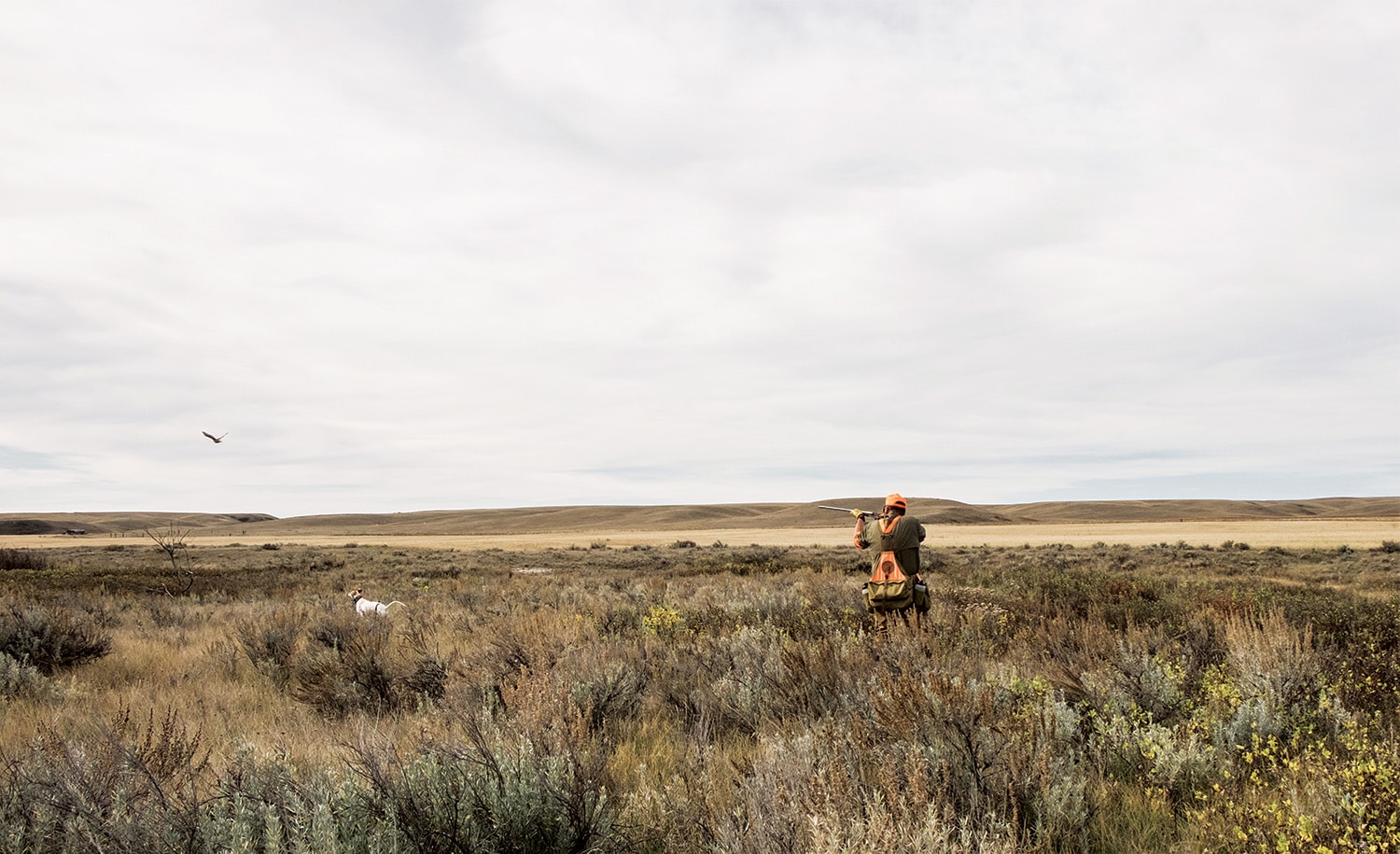
05 Oct Sharptail
A warm September sun hung suspended in the endless prairie sky, reminding me why my new Montana license plates seemed so proud of the sobriquet they bore. To the north of the bluff where I stood, the Missouri wound its way through the breaks like a rattlesnake on the move. If anything in sight had changed since Lewis and Clark passed through this way in 1805, it was well hidden.
Although I’d been using shotguns since early childhood and was hardly new to upland bird hunting, this was my first hunt on the prairie. Several species of legal game birds were out there somewhere, but I had no idea where to look for them in the sea of grass stretching to the south. That knowledge would come, but it would take its own sweet time.
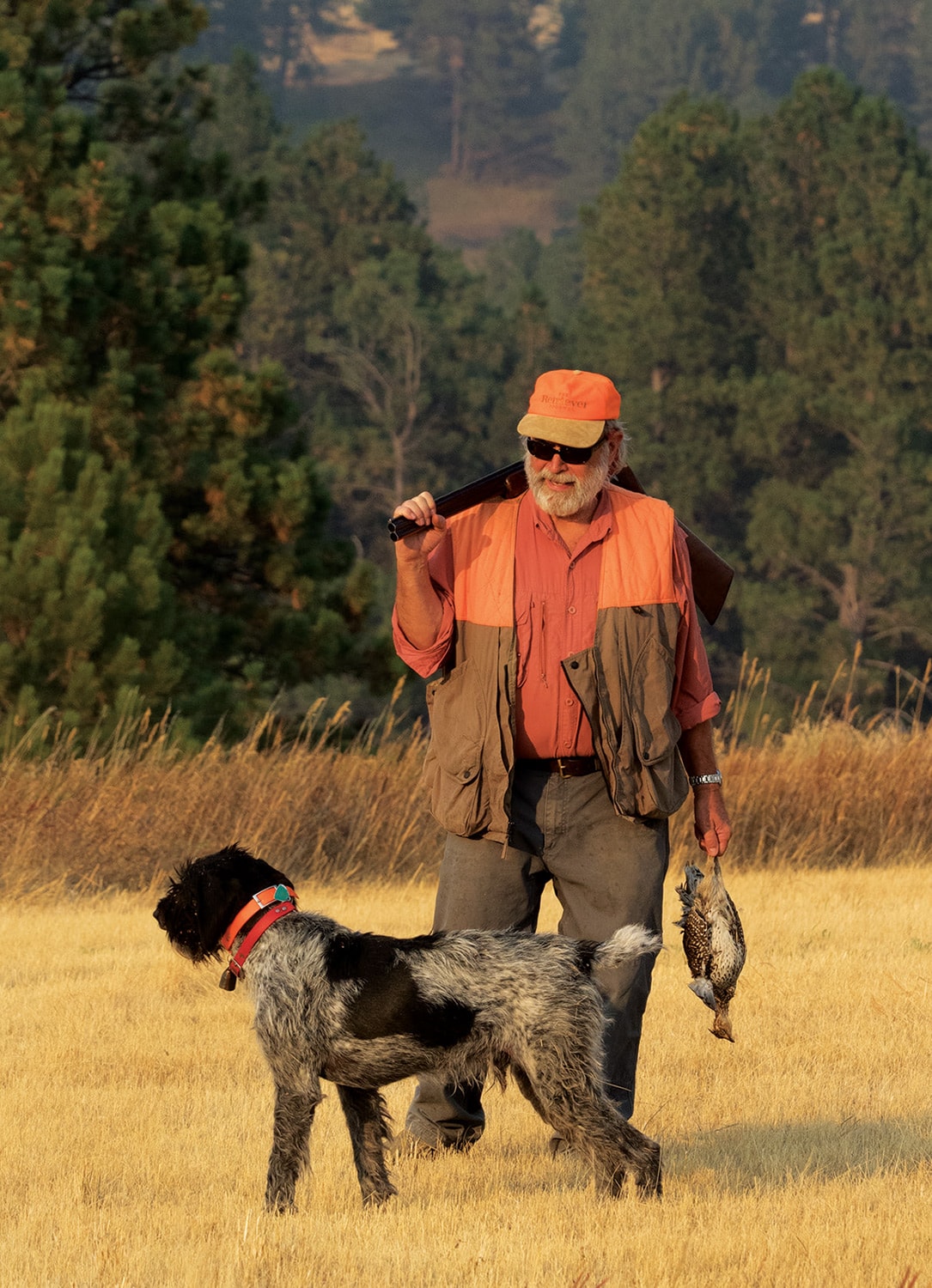 The author hunts sharp-tailed grouse with his dog, a German wirehaired pointer named Max. Photo by Lori Thomas
The author hunts sharp-tailed grouse with his dog, a German wirehaired pointer named Max. Photo by Lori Thomas
A 2-mile random walk, as a theoretical mathematician might have called it, yielded nothing more than sweat and increased fascination with my new environment. Then Bogey screeched to a halt on the downwind side of a wild rose tangle and went on point. The concept of the pointing Lab had barely been invented then, and I never saw Bogey point again. But there he stood frozen like a statue, and I wasn’t about to ignore him.
When I waded into the thorns, the stillness of the prairie shattered, first with a chorus of rich, reedy chuckles and then with the roar of powerful wings. Mottled gray birds erupted in staggered rises. Bogey ran off in pursuit, while I stood, stared, and feinted with my shotgun’s barrels, first in one direction and then another. I had never seen birds of this kind and wanted to avoid shooting an illegal hen pheasant. (That distinction becomes instinctive with experience.) Finally, I correctly identified them as sharp-tailed grouse.
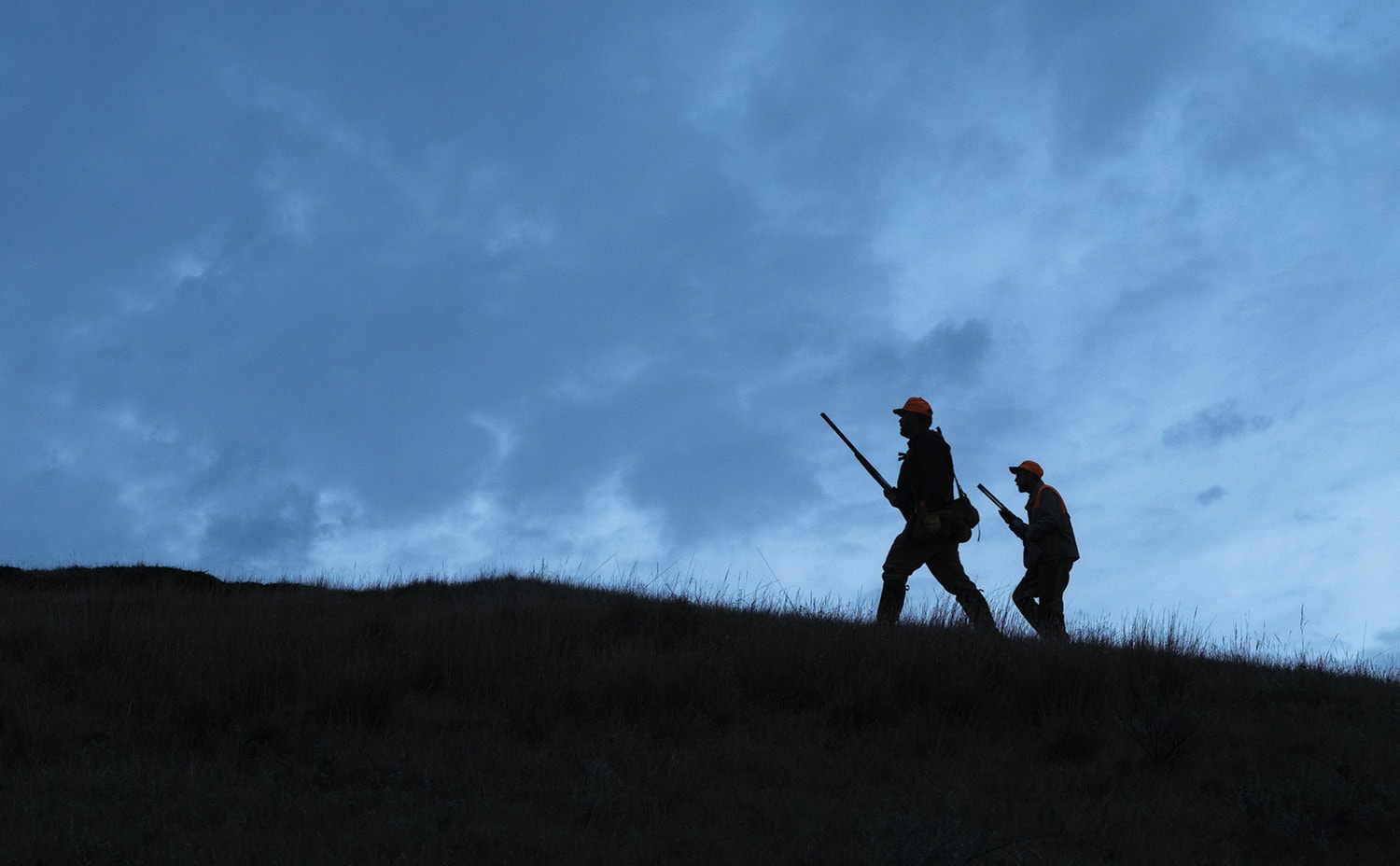 Photo by Brandon McMahon
Photo by Brandon McMahon
That was my initial introduction to sharptails, and my enthusiasm for them has only grown in the decades since.
As long as I’ve been around the prairies of Eastern Montana, sharptails (Tympanuchus phasianellus) have been known colloquially as “chickens.” This misnomer can lead to biological confusion, for no true prairie chickens (T. cupido) inhabit Montana. The first observers to describe both birds for Western science had no trouble with the distinction. On September 12, 1804, William Clark encountered what were clearly sharptails in what is now South Dakota, noting: “The Prairie fowl common to the Illinois are found as high up as the River Jacques above which the Sharpe tailed Grows commence.” (Clark’s spelling was atrocious.) Meriwether Lewis later noted that the tail of the grouse found farther west had “feathers in its center much longer than those on the sides,” while “those of the Illinois had tails composed of feathers of equal length.”
Oh, well. In Eastern Montana, sharptails will always be “chickens.”
These reports from the Lewis and Clark expedition emphasize an important point. Of Montana’s three major prairie upland species, two — the ring-necked pheasant and Hungarian partridge (Hun) — are Old World imports. Discounting real prairie chickens, which don’t live here, and sage grouse, which are more interesting as biological marvels than as game birds, leaves sharptails as the only native game birds on the prairie during upland hunting season. I have nothing against hunting pheasants and Huns, but there is something intangibly appealing about birds native to the habitat.
Like all our native prairie grouse, sharptails engage in complex lekking behavior during spring. At a typical lek, several dozen birds gather at first light in locations that remain constant from year to year. After inflating their lilac-colored throat sacs, males begin to posture, stutter-step in circles, and make eerie cooing noises. Courtly bows, as if greeting royalty, and rattling tail feathers add to the weirdness of the display. Meanwhile, the hens stand around and watch with a remarkable lack of interest. Eventually they breed, but the ritual courtship that precedes each such event must be among the most intricate in nature.
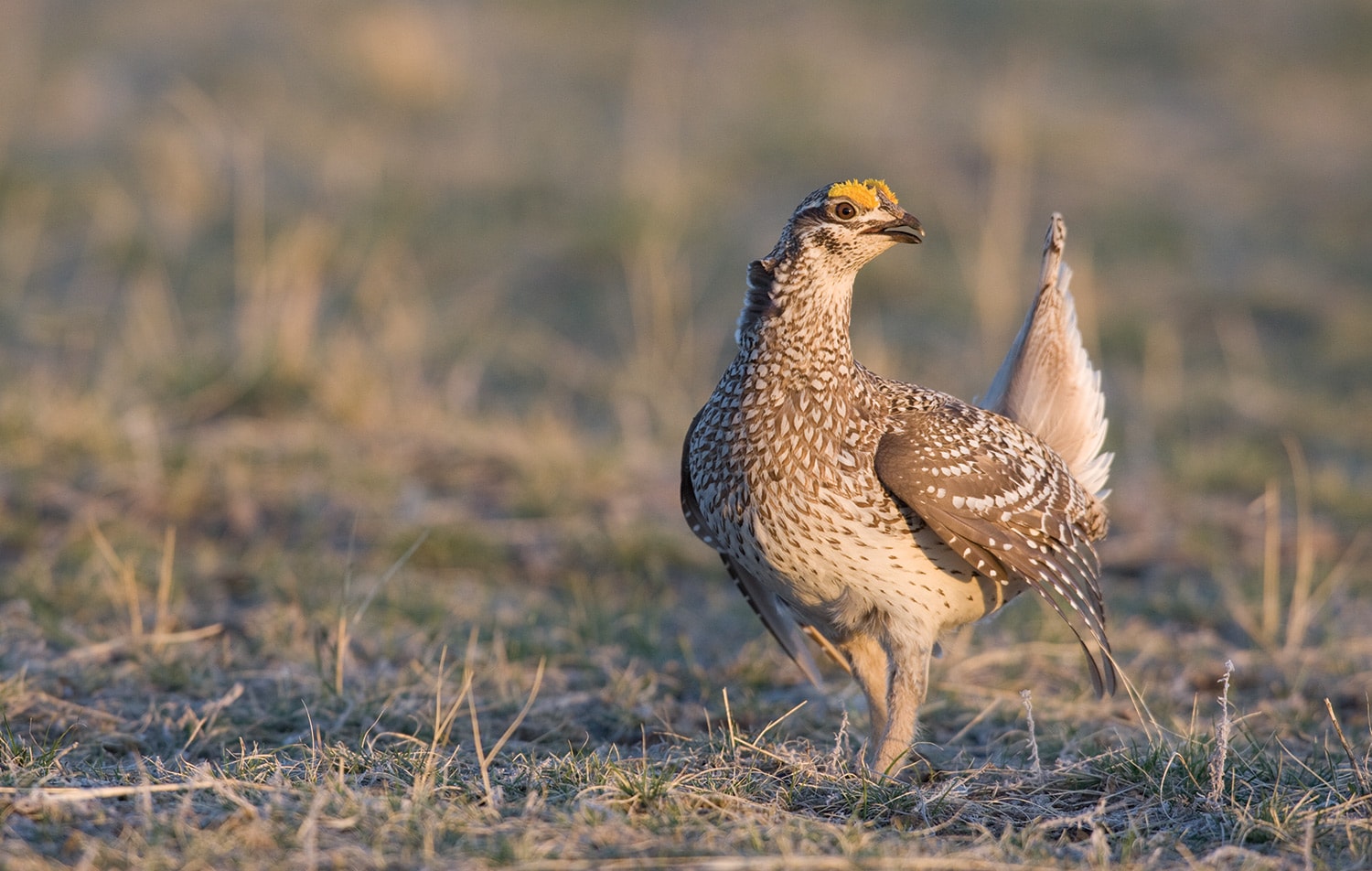 A male sharp-tailed grouse takes on a post-strut pose during a ritual courtship dance called a lek. Photo by Donald M. Jones
A male sharp-tailed grouse takes on a post-strut pose during a ritual courtship dance called a lek. Photo by Donald M. Jones
Whenever I’m hunting sharptails, I’m gathering dinner for a mixture of family and friends, and they likely arouse more culinary controversy than any other Montana game bird. Most hunters agree that sage hens fare poorly on the table, while Huns, pheasants, and mountain grouse earn rave reviews (which they deserve). Confusion about sharptails arises because their table quality varies so much over the course of Montana’s generous four-month hunting season. In September and October, young birds are excellent — tender and succulent, with a distinctive yet subtle flavor. Later on, they become dark, livery, and tough. They’re still edible — I wouldn’t hunt them then if they weren’t — but they do best breasted, cut up, and cooked low and slow with heavy sauces, reserving the chewy legs for stock. Either way, sharptails make a healthy, nutritious meal — the ultimate free-range chickens.
With all due respect to Bogey and better-flushing Labs I’ve trained since, sharptails are made to be hunted with pointing dogs. Upland birds that like to run, like pheasants, can frustrate pointers and be especially confusing for young dogs. Sharptails hold beautifully for dogs on point, at least for the first month or two of the season. Once snow starts to fly, they often congregate in large flocks and become much more difficult to approach, which is why I usually concentrate on pheasants and waterfowl then.
Montana and the Dakotas represent the heart of American sharptail country, but they range as far east as Michigan and north through the Canadian prairie provinces to Alaska. While most experienced sharptail hunters have trouble visualizing them near the Arctic Circle, they are abundant in parts of Alaska’s interior. They share cold weather adaptations with the closely related ptarmigan, right down to the feathers on their feet that help them walk on snow.
Unlike ptarmigan however, sharptail plumage doesn’t turn white in winter. Once snow covers the ground, the intricately patterned feathers that provided such superb camouflage in September fail to conceal them. More vulnerable to predators of all kinds then, sharptails gather in large, wary flocks and always seem to have sentries posted in strategic positions, making an approach to shotgun range difficult or impossible.
It’s December now, and the year’s darkest day is nearly upon us. The wind is blowing 10 to 15 miles per hour from the northwest, and I didn’t have the courage to look at the thermometer on the porch when I left the house. New snow blankets the countryside, making it look like a color photograph that has been converted to black and white. While common sense dictates that I spend the day in front of the fireplace with a good book, I’ve started to experience flashbacks of the serious cabin fever that plagued me when I lived in Alaska. I’ll do anything to avoid that. Besides, the dogs haven’t been anywhere other than the house and the kennel for nearly a week, and they’re getting as squirrely as I am.
An hour’s drive brings us to a friend’s ranch containing some great pheasant cover. I pull cautiously off a familiar two-track, right where I once drove into an irrigation ditch buried beneath a fresh layer of snow. After gearing up — heavy coat, wool stocking cap, shotgun, leather shooting gloves, game vest, whistle — I walk to the back of the truck, drop the tailgate, and prepare for an eruption of canine enthusiasm as I fumble with the latches on the dog box.
My kennel has come a long way since the days when Bogey was its sole occupant. Maggie is a neurotic but highly capable female German wirehair with eight years of experience. Another wirehair, Max, is a gorgeous horse of a dog still too young to know much but bubbling with promise. I’ve trained Rosy, my four-year-old female yellow Lab, as a waterfowl specialist, but I often hunt her from heel in upland cover in case I face a tough recovery that might exceed the wirehairs’ retrieving capabilities.
The heart of the pheasant cover here consists of a long ribbon of brush bordering a spring-fed creek, with stubble fields on both sides. After allowing the dogs an initial frolic in the snow, I whistle the wirehairs in and head toward the willows with Rosy at my side. Then something catches my eye across the field. Further examination reveals a lone sharptail sitting high in a barren cottonwood like an angel atop a Christmas tree.
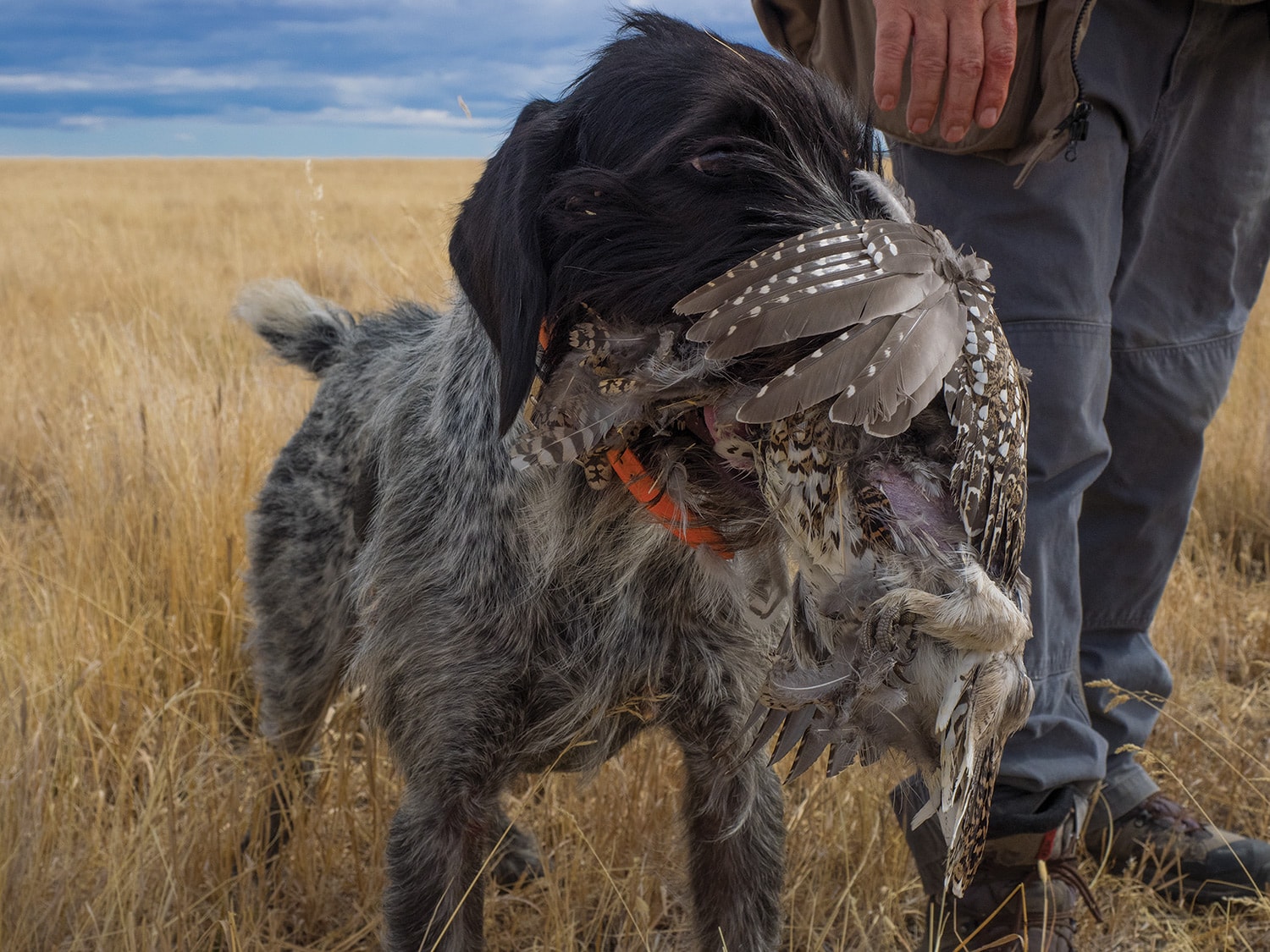 Max is one of the author’s loyal hunting companions. Photo by Lori Thomas
Max is one of the author’s loyal hunting companions. Photo by Lori Thomas
The grouse sits quietly and motionless while we cross the field. As we draw nearer, I can see a dozen more sharptails silhouetted against the snow as they scratch for leftover grain. With the wind at our backs, the bird dogs can’t smell anything to point. I’m still 20 yards short of shotgun range when the sentry in the tree sounds an alarm chuckle and takes wing. This initiates a chain reaction on the ground as grouse begin to flush wildly, a dozen at first and then so many I can’t count.
The cottonwood sits along a ditch that contains enough brush to hold birds that would rather hide than fly. The best one can hope for in this situation is a straggler or two that choose to do just that. Maggie and Rosy are steady to wing and shot, but young Max hasn’t reached that point in his education yet. While he gallops across the field in a futile attempt to outrun the flying grouse, I run Maggie through the cover in search of birds left behind. There aren’t any.
There are pheasants back along the creek though, and by the time we head for home to thaw out, three of them are resting in my game vest. After all their hard work in the cold, the dogs ride up front with me in the truck’s heated cab, but they’re too tired to laugh at my jokes. An honest limit of late season roosters is always an accomplishment, but I already know that my memories of the day will focus on those clouds of sharptails.
The fact that I didn’t get a shot at any of them scarcely matters.




No Comments